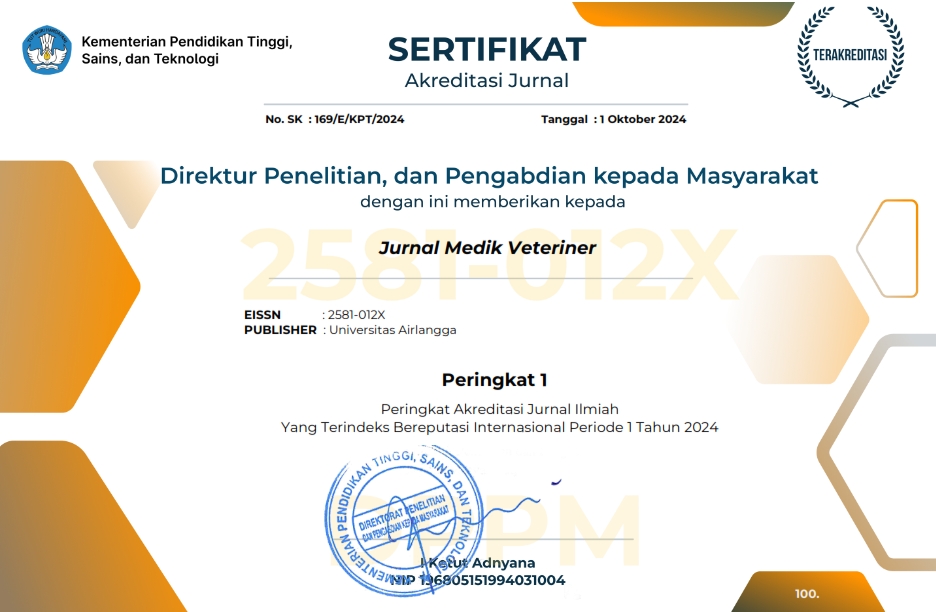Quantifying Zoonotic Risk from Cats (Felis catus, Felidae: Carnivora): A Systematic Meta-Analysis of Pathogen Prevalence

Downloads
Cats are known to be potential reservoirs for a variety of zoonotic pathogens. However, the overall prevalence of zoonotic pathogens in the cat population remains unclear amid growing concerns. This study aimed to measure the combined prevalence of zoonotic pathogens in cats through a systematic review and meta-analysis. Relevant literature reporting the prevalence of zoonotic pathogens in cats, published from 2015 to 2025, was collected from databases. A total of 49 studies met the inclusion criteria, encompassing a total sample size of 18,206 cats. A meta-analysis was performed using a random-effects model. Toxoplasma gondii, Bartonella henselae, and Campylobacter spp. were the most frequently reported pathogens, with pooled prevalence estimates presented with 95% confidence intervals (CIs). The I² statistic was used to assess heterogeneity. The combined prevalence of zoonotic pathogens in cats was estimated at 24% (95% CI: 17–32%). Considerable heterogeneity was observed among the studies (I² = 98.4%, p < 0.001), and this likely reflects differences in geographic region, diagnostic methods, and pathogen type. Individual study prevalences ranged from 0.02 to 0.97, with varying weights according to sample size and variance. This meta-analysis highlights the relatively high prevalence of zoonotic pathogens among cats. The relevance of applying a One Health perspective is emphasized by these findings for the development of evidence-based public health policies to reduce zoonotic risks at the community and global levels.
Abbas, I., Al-Araby, M., Elmishmishy, B., & El-Alfy, E. S. (2022). Gastrointestinal parasites of cats in Egypt: high prevalence high zoonotic risk. BMC Veterinary Research, 18(1), 420.
Abdulwahab, M. H., & Al-Thalib, H. (2024). Estimation of protozoal diversity among stray cats in Malaysia. Biodiversitas, 25(5), 2115–2120.
Alonte, A. J. I., Manalo, S. M. P., Betson, M. E., Divina, B. P., & Paller, V. G. V. (2024). Companion Animals as Reservoirs and Sentinels for Zoonotic Helminths in Selected Rural Communities in Agusan del Sur and Surigao del Norte, Philippines. The Philippine Journal of Veterinary Medicine, 61(2), 32–46.
Andityas, M., Nuraini, D. M., Sota, P., Loong, S. K., Sripa, B., Sukon, P., Tangkawattana, P., & Tangkawattana, S. (2024). Feline leptospirosis prevalence worldwide: A systematic review and meta-analysis of diagnostic approaches. Veterinary World, 17(2), 255–272.
Attipa, C., Yiapanis, C., Tasker, S., & Diakou, A. (2021). Seroprevalence of Toxoplasma gondii in cats from Cyprus. Pathogens, 10(7), 882.
Barılı, Ö., Tuygun, T., Gençay Topçu, E. B., & Umur, Ş. (2023). The parasites of cats in Türkiye. Turkiye Parazitoloji Dergisi, 47(3), 190–199.
Barrs, V. R., Beczkowski, P. M., Talbot, J. J., Hobi, S., Teoh, S. N., Hernandez Muguiro, D., Shubitz, L. F., & Sandy, J. (2024). Invasive fungal infections and oomycoses in cats: 1. diagnostic approach. Journal of Feline Medicine and Surgery, 26(1), 1098612X231219696.
Brennan, A., Hawley, J., Dhand, N., Boland, L., Beatty, J. A., Lappin, M. R., & Barrs, V. R. (2020). Seroprevalence and risk factors for Toxoplasma gondii infection in owned domestic cats in Australia. Vector Borne and Zoonotic Diseases, 20(4), 275–280.
Collela, V., Nguyen, V. L., Tan, D. Y., Lu, N., Fang, F., Zhijuan, Y., Wang, J., Liu, X., Chen, X., Dong, J., Nurcahyo, W., Hadi, U., Venturina, V., Tong, K., Tsai, Y., Taweethavonsawat, P., Tiwananthagorn, S., Le, T., Bui, K., Watanabe, M., Rani, P., Annoscia, G., Beugnet, F., Otranto, D., & Halos, L. (2020). Zoonotic vectorborne pathogens and ectoparasites of dogs and cats in eastern and Southeast Asia. Emerging Infectious Diseases, 26(6), 1221–1233.
Cong, W., Elsheikha, H. M., Zhou, N., Peng, P., Qin, S. Y., Meng, Q. F., & Qian, A. D. (2018). Prevalence of antibodies against Toxoplasma gondii in pets and their owners in Shandong province, Eastern China. BMC Infectious Diseases, 18(1), 430.
Doliff, R., & Martens, P. (2022). Cats and SARS-CoV-2: A Scoping Review. Animals, 12(11), 1413.
Dróżdż, M., Małaszczuk, M., Paluch, E., & Pawlak, A. (2021). Zoonotic potential and prevalence of Salmonella serovars isolated from pets. Infection Ecology & Epidemiology, 11(1), 1975530.
Duijvestijn, M. B. H. M., Schuurman, N. N. M. P., Vernooij, J. C. M., van Leeuwen, M. A. J. M., Bosch, B. J., van den Brand, J. M. A., Wagenaar, J. A., van Kuppeveld, F. J. M., Egberink, H. F., & Verhagen, J. H. (2023). Serological survey of Retrovirus and Coronavirus infections, including SARS-CoV-2, in rural stray cats in the Netherlands, 2020–2022. Viruses, 15(7), 1531.
Elmonir, W., Mabrouk, I., Mohamed, R. A., El-Tras, W. F., & Hegazy, Y. (2023). Prevalence and Risk Factors for Toxoplasma gondii Infection at the CatHuman Interface in Gharbia Governorate, Nile Delta, Egypt. Egyptian Journal Veterinary Science, 54(7), 273–284.
Elnageh, H. R., Hiblu, M., Abbassi, M. S., Abouzeed, Y. M., & Ahmed, M. O. (2021). Prevalence and antimicrobial resistance of Salmonella serotypes isolated from cats and dogs in Tripoli, Libya. Veterinaria Italiana, 57(2), 111–118.
Etter, E., Tagwireyi, W. M., & Neves, L. (2019). Seroprevalence and associated risk factors of Toxoplasma gondii infection in domestic animals in southeastern South Africa. The Onderstepoort Journal of Veterinary Research, 86(1), e1–e6.
Firdausy, L. W., Fikri, F., Wicaksono, A. P., Çalışkan, H., & Purnama, M. T. E. (2025). Prevalence of trypanosomiasis in domesticated animals in Indonesia: A systematic review and meta-analysis. Veterinary World, 18(5), 1333–1344.
Fritz, M., Elguero, E., Becquart, P., De Riols de Fonclare, D., Garcia, D., Beurlet, S., Denolly, S., Boson, B., Rosolen, S. G., Cosset, F. L., Briend-Marchal, A., Legros, V., & Leroy, E. M. (2025). A large-scale serological survey in pets from October 2020 through June 2021 in France shows significantly higher exposure to SARS-CoV-2 in cats compared to dogs. Zoonoses and Public Health, 72(2), 184–193.
Gupta, A. K., Wang, T., Susmita, Talukder, M., & Bakotic, W. L. (2025). Global dermatophyte infections linked to human and animal health: A scoping review. Microorganisms, 13(3), 575.
Handoko, J. (2025). Zoonotic diseases berdasarkan reservoir utamanya. In A. S. Nasution (Ed.), Pengendalian Penyakit Tular Vektor dan Zoonotic Disease. Future Science Publisher, p: 75.
Handoko, J., & Agusthusana, I. G. A. E. (2024). Risk factors associated with feline scabies at a veterinary clinic in municipal Pekanbaru. Jurnal Kajian Veteriner, 12(2), 182–189.
Hassanien, H. A., Sayed, R. H., & Elyazeed, H. S. A. (2021). Cross-sectional study on dermatological affections of companion animals caused by dermatophytes and other keratinophilic fungi in greater cairo area, Egypt. Advances in Animal and Veterinary Science, 9(4), 615–622.
Lakhamsen, N., Chaisongkhram, C., Pattarasuplerk, Y., Macotpet, A., Seesupa, S., Lertitthikul, N., Bupata, P., & Kunkitti, P. (2022). Serological survey of Toxoplasma gondii infection in cats in Khon Kaen, Northeast Thailand. Veterinary World, 15(7), 1779–1784.
Lecca, L. O., Paiva, M. T., de Oliveira, C. S. F., Morais, M. H. F., de Azevedo, M. I., Bastos, C. V. E., Keller, K. M., Ecco, R., Alves, M. R. S., Pais, G. C. T., Salvato, L. A., Xaulim, G. M. D., Barbosa, D. S., Brandão, S. T., & Soares, D. F. M. (2020). Associated factors and spatial patterns of the epidemic sporotrichosis in a high density human populated area: A cross-sectional study from 2016 to 2018. Preventive Veterinary Medicine, 176, 104939.
Li, L., Sui, Y., Li, X., Song, P., Chen, G., Liu, H., Zuo, S., Guo, J., Wang, Q., Sun, Q., Dai, H., Li, J., Zhang, T., Liu, F., Zhang, L., & Dong, H. (2024). Molecular characterization of Cryptosporidium spp. and Giardia duodenalis in pet cats in Henan Province, central China. Acta Tropica, 254, 107188.
Mazotta, E., Lucchese, L., Corrò, M., Ceglie, L., Danesi, P., Capello, K., & Natale, A. (2024). Zoonoses in dog and cat shelters in North-East Italy: update on emerging, neglected and known zoonotic agents. Frontiers in Veterinary Science, 11, 1490649.
Moola, S., Munn, Z., Tufanaru, C., Aromataris, E., Sears, K., Sfetcu, R., Currie, M., Qureshi, R., Mattis, P., Lisy, K., & Mu, P. F. (2020). Systematic reviews of etiology and risk. In: E. Aromataris., & Munn, Z (Eds.), JBI Manual for Evidence Synthesis. JBI.
Moskaluk, A. E., & VandeWoude, S. (2022). Current topics in dermatophyte classification and clinical diagnosis. Pathogens, 11(9), 957.
Mūrniece, G., Šteingolde, Ž., Cvetkova, S., Valciņa, O., Zrelovs, Ņ., Brīvība, M., Kloviņš, J., Birzniece, L., Megnis, K., Fridmanis, D., Bērziņš, A., Kovaļčuka, L., & Kovaļenko, K. (2024). Prevalence of SARS-CoV-2 in domestic cats (Felis catus) during COVID-19 pandemic in Latvia. Veterinary Medicine and Science, 10(3), e1338.
Neves, M., Lopes, A. P., Martins, C., Fino, R., Paixão, C., Damil, L., Lima, C., Alho, A. M., Schallig, H. D. F. H., Dubey, J. P., & Cardoso, L. (2020). Survey of Dirofilaria immitis antigen and antibodies to Leishmania infantum and Toxoplasma gondii in cats from Madeira island, Portugal. Parasites and Vectors, 13, 117.
Nguyen, V. L., Dantas-Tores, F., & Otranto, D. (2021). Canine and feline vector-borne diseases of zoonotic concern in Southeast Asia. Current Research in Parasitology and Vector-Borne Diseases, 1, 100001.
Núñez, C. R., Contreras, L. M., & Cardenas, R. H. (2021). The prevalence and risk factors of Giardia duodenalis infection in cats in Mexico. Journal of Advances in Medicine and Medical Research, 33(23), 168–176.
Nyambura Njuguna, A., Kagira, J. M., Muturi Karanja, S., Ngotho, M., Mutharia, L., & Wangari Maina, N. (2017). Prevalence of Toxoplasma gondii and other gastrointestinal parasites in domestic cats from households in Thika Region, Kenya. BioMed Research International, 2017, 7615810.
Page, M. J., Moher, D., Bossuyt, P. M., Boutron, I., Hoffmann, T. C., Mulrow, C. D., Shamseer, L., Tetzlaff, J. M., Akl, E. A., Brennan, S. E., Chou, R., Glanville, J., Grimshaw, J. M., Hróbjartsson, A., Lalu, M. M., Li, T., Loder, E. W., Mayo-Wilson, E., McDonald, S., McGuinness, L. A., Stewart, L. A., Thomas, J., Tricco, A. C., Welch, V. A., Whiting, P., & McKenzie, J. E. (2021). PRISMA 2020 explanation and elaboration: updated guidance and exemplars for reporting systemic reviews. BMJ, 372, n160.
Peterson, B., & Barnes, A. N. (2020). Feline-human zoonosis transmission in North Africa: A systematic review. Vector Borne and Zoonotic Diseases, 20(10), 731–744.
Poulle, M. L., Bastien, M., Richard, Y., Josse-Dupuis, É., Aubert, D., Villena, I., & Knapp, J. (2017). Detection of Echinococcus multilocularis and other foodborne parasites in fox, cat and dog faeces collected in kitchen gardens in a highly endemic area for alveolar echinococcosis. Parasite (Paris, France), 24, 29.
Rabaan, A. A., Uzairue, L. I., Alfaraj, A. H., Halwani, M. A., Muzaheed, Alawfi, A., Alshengeti, A., Al Kaabi, N. A., Alawad, E., Alhajri, M., Alwarthan, S., Alshukairi, A. N., Almuthree, S. A., Alsubki, R. A., Alshehri, N. N., Alissa, M., Albayat, H., Zaidan, T. I., Alagoul, H., Fraij, A. A., & Alestad, J. H. (2023). Seroprevalence, risk factors and maternal-fetal outcomes of Toxoplasma gondii in pregnant women from WHO eastern Mediterranean region: systematic review and meta-analysis. Pathogens, 12(9), 1157.
Rocha, A. V. V. O., Moreno, B. F. S., Cabral, A. D., Louzeiro, N. M., Miranda, L. M., Santos, V. M. B. D., Costa, F. B., Nogueira, R. M. S., Marcili, A., Sperança, M. A., & Costa, A. P. D. (2019). Diagnosis and epidemiology of Leishmania infantum in domestic cats in an endemic area of the Amazon region, Brazil. Veterinary Parasitology, 273, 80–85.
Sawitri, D. H., Wardhana, A. H., Nefho, F., Purwanto, E. S., Endrawati, D., Nugraheni, Y. R., Primatika, R. A., Damayanti, N. A., Akbari, R. A., Kusumaningtyas, E., & Matsubayashi, M. (2024). Prevalence and risk factors associated with zoonotic gastrointestinal helminths transmitted by cats in Jabodetabek, Indonesia. Open Veterinary Journal, 14(10), 2551–2563.
Scorza, A. V., & Lappin, M. R. (2017). Prevalence of Selected Zoonotic and Vector-Borne Agents in Dogs and Cats on the Pine Ridge Reservation. Veterinary Sciences, 4(3), 43.
Sharma, V., Sharma, R., Aulakh, R., & Singh, B. (2023). Prevalence of Brucella species in stray cattle, dogs and cats: A systematic review. Preventive Veterinary Medicine, 219, 106017.
Souza, J. B. B., Silva, Z. M. A., Alves-Ribeiro, B. S., Moraes, I. S., Alves-Sobrinho, A. V., Saturnino, K. C., Ferraz, H. T., Machado, M. R. F., Braga, Í. A., & Ramos, D. G. S. (2023). Prevalence of intestinal parasites, risk factors and zoonotic aspects in dog and cat populations from Goiás, Brazil. Veterinary Sciences, 10(8), 492.
Springer, A., Glass, A., Topp, A. K., & Strube, C. (2020). Zoonotic tick-borne pathogens in temperate and cold regions of Europe-a review on the prevalence in domestic animals. Frontiers in Veterinary Science, 7, 604910.
Symeonidou, I., Gelasakis, A. I., Arsenopoulos, K., Angelou, A., Beugnet, F., & Papadopoulos, E. (2018). Feline gastrointestinal parasitism in Greece: emergent zoonotic species and associated risk factors. Parasites & Vectors, 11(1), 227.
Szentivanyi, T., Oedin, M., & Rocha, R. (2024). Cat–wildlife interactions and zoonotic disease risk: a call for more and better community science data. Mammal Review, 54(2), 93–104.
Takano, A., Morinaga, D., Teramoto, I., Hatabu, T., Kido, Y., Kaneko, A., Hatta, T., Tsuji, N., Uni, S., Sasai, K., Katoh, H., & Matsubayashi, M. (2024). Evaluation of the detection method by a flotation method using a wire loop for gastrointestinal parasites. Veterinary Medicine and Science, 10(5), e70007.
Teng, L., Liao, S., Zhou, X., Jia, C., Feng, M., Pan, H., Ma, Z., & Yue, M. (2022). Prevalence and Genomic Investigation of Multidrug-Resistant Salmonella Isolates from Companion Animals in Hangzhou, China. Antibiotics, 11(5), 625.
Turcotte, A. F., O’Connor, S., Morin, S. N., Gibbs, J. C., Willie, B. M., Jean, S., & Gagnon, C. (2021). Association between obesity and risk of fracture, bone mineral density and bone quality in adults: a systematic review and meta-analysis. PloS one, 16(6), e0252487.
Veyna-Salazar, N. P., Cantó-Alarcón, G. J., Olvera-Ramírez, A. M., Ruiz-López, F. J., Bernal-Reynaga, R., Bárcenas-Reyes, I., & Durán-Aguilar, M. (2023). Occurrence of Giardia duodenalis in cats from Queretaro and the risk to public health. Animals, 13(6), 1098.
Viechtbauer, W. (2010). Conducting Meta-Analyses in R with the metafor Package. Journal of Statistical Software, 36(3), 1–48.
Villanueva-Saz, S., Martínez, M., Rueda, P., Pérez, M. D., Lacasta, D., Marteles, D., Ruíz, H., Gonzalez, A., Verde, M. T., Pardo, J., Arias, M., Peña-Fresneda, N., Fernández, A., & Trotta, M. (2024). Serological exposure to influenza A in cats from an area with wild birds positive for avian influenza. Zoonoses and Public Health, 71(3), 324–330.
Wada, Y., Irekeola, A., Engku, N. S. E., Yusof, W., Huey, L., Muhammad, S., Harun, A., Yean, C., & Zaidah, A. (2021). Prevalence of vancomycin-resistant enterococcus (Vre) in companion animals: The first meta-analysis and systematic review. Antibiotics, 10(2), 1–17.
Yurayart, C., Niae, S., Limsivilai, O., Thengchaisri, N., & Sattasathuchana, P. (2024). Comparative analysis of the distribution and antifungal susceptibility of yeast species in cat facial hair and human nails. Scientific Reports, 14(1), 14726.
Copyright (c) 2025 Jully Handoko, Arya Marganda Simanjuntak, Suyanto Suyanto, Theerakamol Pengsakul, Yuli Susana, Rian Maulana, Enikarmila Asni, Soedarmanto Indarjulianto

This work is licensed under a Creative Commons Attribution-NonCommercial-ShareAlike 4.0 International License.
Authors who publish in this journal agree to the following terms:
1. The journal allows the author to hold the copyright of the article without restrictions;
2. The journal allows the author(s) to retain publishing rights without restrictions;
3. The legal formal aspect of journal publication accessibility refers to Creative Commons Attribution-NonCommercial-ShareAlike 4.0 International License (CC BY-NC-SA).






11.jpg)




















